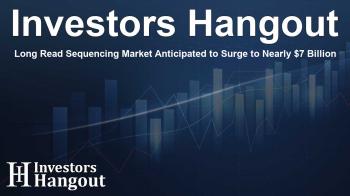Long Read Sequencing Market Anticipated to Surge to Nearly $7 Billion

Long Read Sequencing Market Overview
The Long Read Sequencing market is experiencing remarkable growth, with projections indicating it will reach USD 6.98 billion in the near future. This rapid expansion is primarily driven by advancements in genomics and precision medicine. Today, Long Read Sequencing plays a vital role in enhancing genomic research and improving the diagnostics of genetic diseases.
Growth Trajectory and Market Drivers
According to recent analyses, the Long Read Sequencing market was valued at approximately USD 595.91 million in 2023 with expectations to grow at a significant CAGR of 31.53% from 2024 to 2032. This surge is attributed to the rising adoption of next-generation sequencing (NGS) technologies that are essential for genomics breakthroughs, accuracy in diagnostics, and personalized medicine approaches.
The Role of Long Read Sequencing
This innovative sequencing technology provides high accuracy for detecting structural variants and complex genomic rearrangements, aspects that often remain undetected by traditional short-read approaches. The increased precision and detailed insights into genetic material pave the way for significant advancements in cancer genomics and rare disease diagnostics.
U.S. Market Insights
In the United States alone, the Long Read Sequencing market had a valuation of USD 220.26 million in 2023, projected to surge to about USD 2,541.49 million by 2032, reflecting a robust CAGR of 31.31%. The U.S. maintains a dominant position in the North American market largely due to extensive federal investment in genomics research. The combination of cutting-edge research institutions and a supportive infrastructure enhances the landscape for precision medicine.
Government Support and Market Development
Federal initiatives, such as the NIH's All of Us Research Program, further foster market growth. Additionally, platforms that harness advanced technologies, such as PacBio and Oxford Nanopore, are being widely adopted across cancer genomics and advanced diagnostic testing scenarios.
Key Players Shaping the Market
Several influential companies are at the forefront of the Long Read Sequencing market:
- Pacific Biosciences of California, Inc.
- Oxford Nanopore Technologies plc.
- Illumina, Inc.
- F. Hoffmann-La Roche Ltd.
- Element Biosciences
- BGI Genomics
- New England Biolabs
- Agilent Technologies, Inc.
- QIAGEN N.V.
- Bionano Genomics
These companies are essential to the ongoing development of tools and technologies that drive the industry forward, ensuring the continuous enhancement of library preparation kits and other vital reagents.
Market Segmentation and Trends
Insights show that the consumables segment is a major contributor to the Long Read Sequencing market, holding a dominant share of 62.46% as of 2024. This is largely due to the recurring need for reagents, kits, and cartridges in sequencing workflows.
Technological Advancements
Among the technological aspects, nanopore sequencing has emerged as a leader, accounting for 62.25% of the market share in 2024. Its strengths include real-time analysis and the flexibility to work with various sample types, which are essential features driving its rapid adoption.
Future Outlook for Asia Pacific
Regionally, North America leads the market with around 51.11% of the total share, bolstered by a strong research infrastructure and investment opportunities. However, the Asia Pacific region is projected to witness the fastest growth, benefiting from increasing healthcare investments and a rising demand for personalized therapies. Countries such as China, Japan, and India are enhancing their genomic research capabilities significantly.
Conclusion
Overall, the Long Read Sequencing market is on a strong upward trajectory, with numerous opportunities for growth fueled by technological advancements and increasing healthcare demands globally. Innovations in sequencing technology combined with supportive governmental initiatives will continue to drive market expansion and enhance precision medicine's effectiveness.
Frequently Asked Questions
What is the expected market size of Long Read Sequencing by 2032?
The Long Read Sequencing market is projected to reach approximately USD 6.98 billion by 2032.
What factors are driving growth in the Long Read Sequencing market?
The growth is primarily driven by the increasing adoption of next-generation sequencing technologies and advancements in genomic research.
Which segment of the market is leading in terms of share?
The consumables segment dominates the Long Read Sequencing market with a substantial market share due to the necessity of ongoing purchases for sequencing workflows.
How is the U.S. market performing in Long Read Sequencing?
The U.S. market was valued at USD 220.26 million in 2023 and is forecasted to grow significantly to approximately USD 2,541.49 million by 2032.
What role does government funding play?
Government funding, particularly through initiatives like the NIH's All of Us Research Program, greatly amplifies market growth and enhances research capabilities within the sector.
About The Author
Contact Evelyn Baker privately here. Or send an email with ATTN: Evelyn Baker as the subject to contact@investorshangout.com.
About Investors Hangout
Investors Hangout is a leading online stock forum for financial discussion and learning, offering a wide range of free tools and resources. It draws in traders of all levels, who exchange market knowledge, investigate trading tactics, and keep an eye on industry developments in real time. Featuring financial articles, stock message boards, quotes, charts, company profiles, and live news updates. Through cooperative learning and a wealth of informational resources, it helps users from novices creating their first portfolios to experts honing their techniques. Join Investors Hangout today: https://investorshangout.com/
The content of this article is based on factual, publicly available information and does not represent legal, financial, or investment advice. Investors Hangout does not offer financial advice, and the author is not a licensed financial advisor. Consult a qualified advisor before making any financial or investment decisions based on this article. This article should not be considered advice to purchase, sell, or hold any securities or other investments. If any of the material provided here is inaccurate, please contact us for corrections.

